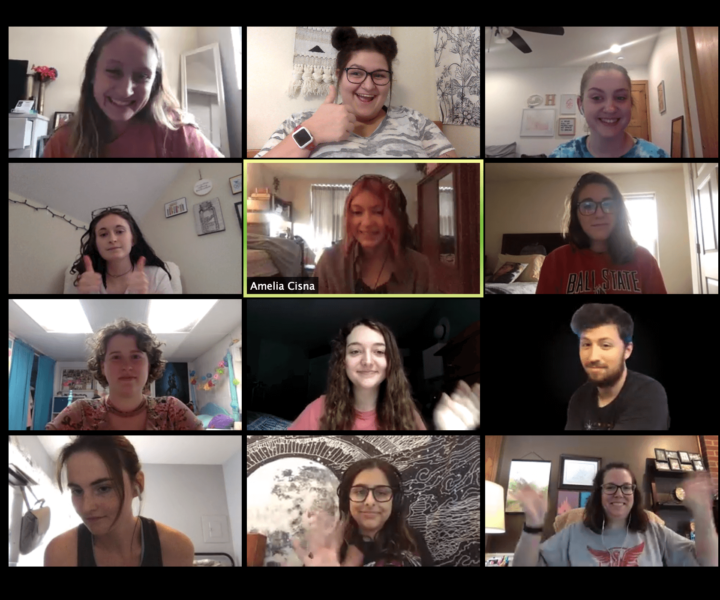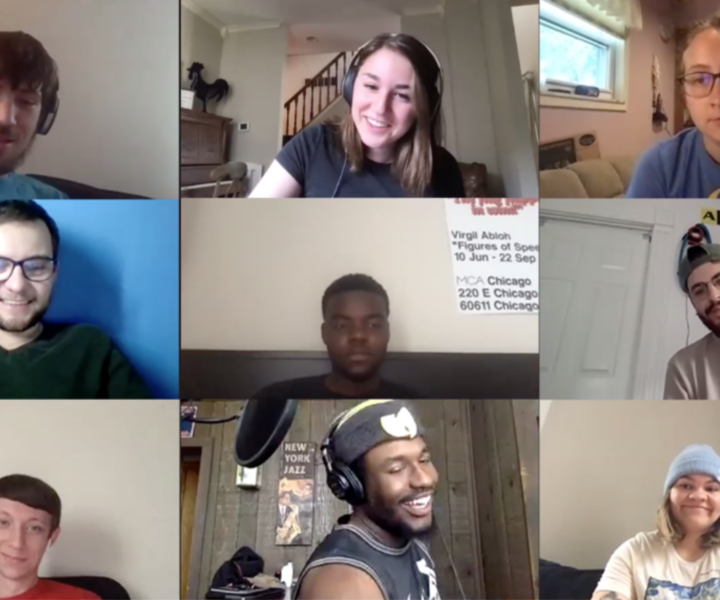There are two main types of thinkers in this world: people who are more realistic and people who are more idealistic. But the world isn’t totally black and white like that, is it?
I used to think that my mom and dad weren’t creative people because their jobs weren’t in writing, music, or art. The harder I looked, though, the more I realized how creative their hobbies were and how that spread into aspects of their jobs. My mom, for example, is a leasing agent. She made all my costumes when I was younger, has been doing my hair since birth, and is the most out-of-the-box gift giver I’ve met in my life. Yes — her job is to give tours, email tenants, and send in work orders – but she also makes welcome packages for tenants, had ideas to spice up the décor in the office with handmade paintings, and constantly thinks of creative ways to market the complex to prospective tenants. Personally, I’ve worked many jobs since I turned 16, and there was not one where I didn’t have to use creative problem-solving skills to resolve a sticky situation or improve the business.
Thinking Differently
If we’re getting technical, there are essentially 3 main modes of thinking: divergent, convergent, and lateral thinking. Divergent thinkers use an imaginative approach to thinking where they take a question and brainstorm different ways to answer it. Convergent thinkers use logic and consider hard facts to get to an answer. Lateral thinkers use both to think out of the box. Lateral thinking is more concerned with the “movement value” of statements and ideas, meaning that people who think this way will use a known idea and take it as inspiration to form new ideas. Although this is a very technical way to break down thinking, as far as creativity goes, there are many different types of creative thinkers out there.
Another way to break down the way we think is from this “My Creative Type” test from Adobe Create that explains eight different creative types. It’s not always black and white like this, though. People are complex, and we can always try and break them down between people who are more thinkers versus doers, but the reality is that everybody is a mixture of creative types. There are some creative types that play more to certain strengths than others, and that’s why taking these tests is so beneficial because they can help us understand how we think and approach problems better.
Applying These Creative Types and Modes of Thinking to the Real World
Let’s say you work in finance. You are your company’s treasurer and must direct your company’s budget to meet financial goals. You must decide what to spend your budget on, analyze your greatest assets, and decipher what is bringing people into your business. You can do this by looking at engagement on social media, employee reports, and more.
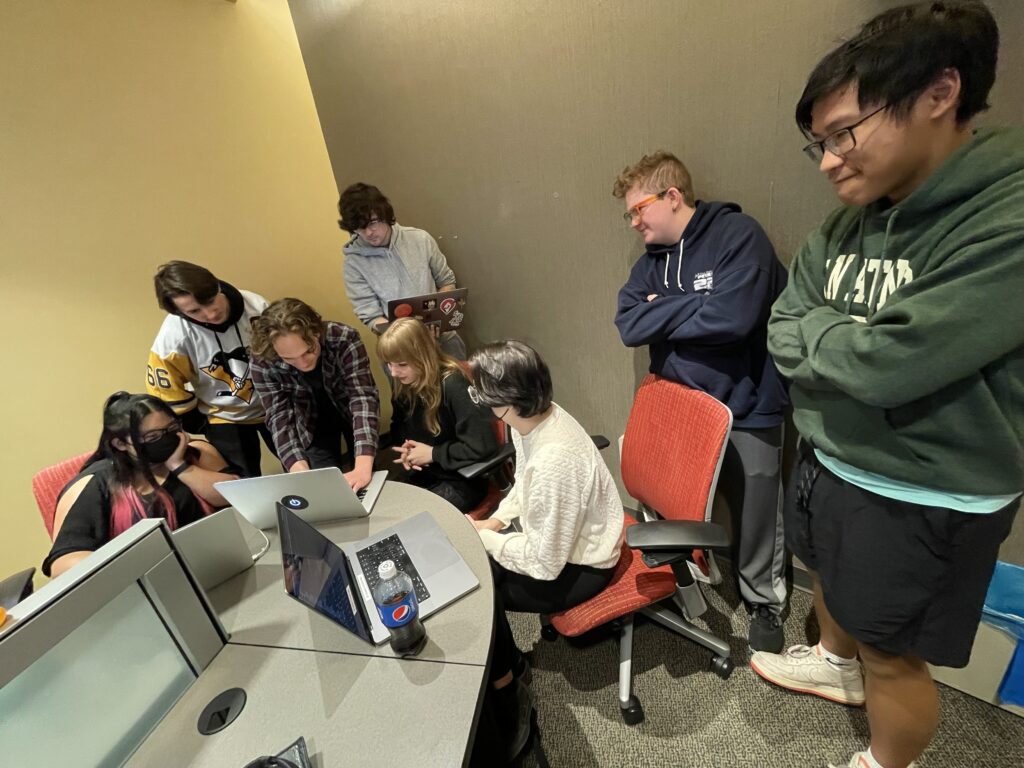
From left, Kiri W., Joah D., Tyler N., Drew H., Desiree N., and Mars W., Connor V., and Kevin Y., all members of the Development Team, collaborate on a project.
How Do They Affect the Digital Corps?
Kiri, Desiree, and Mars are on the Development Team here at the Corps, but they all received different creative types from the Adobe quiz. Mars got “thinker,” Kiri got “visionary,” and Desirée got “dreamer.” We’ve also held many Soft Skills sessions at the Corps talking about different people’s strengths and traits, and everyone varies so much. That’s why we work so well together. If we all thought the same way, new ideas wouldn’t be as common, and we’d be restricted to only certain perspectives and ways of thinking. Every agency should have a team that varies in their modes of thinking. The best way to succeed in an agency setting is to have variety and people bringing different ideas and solutions to the table. I’m sure in the hiring process this happens subconsciously sometimes, but it’s something to be aware of. At the Corps, on the Communcation Team, some of us write better for tech and copy while others write better for storytelling. It’s perfect because we all complement each other and learn from each other’s individual strengths.
Creativity Is Everywhere
Whether you realize it or not, you’re using creativity to problem-solve all the time. Every single person is creative in their own ways, no matter what field you’re in. If you’re an artist who thought of an original character design and you start drawing it, that’s creative! If you’re a real estate agent that must find ways to market your properties, that’s creative too!
We all learn to problem solve in our own ways based on what’s comfortable to us. This article by GCFGlobal called, “Everyone Can Be Creative” expanded on this saying, “You can use creativity to paint or write poems, but you can also use it in practical ways like coming up with an alternative solution for a work project or organizing things in your home.”
Our Development and Design Team Lead, Riley Paulsen, would label himself more of a divergent thinker. His first resort to solving a problem is to approach it by creating multiple ideas from one problem first. When I asked him how we are creative at the Corps, he said, “I think there’s an inherent creativity in problem solving and exposing people to lots of questions that may not have easy answers. Our students are going to be able to take themselves out of their comfort zone or their existing domain of knowledge and hopefully pull in some outside influences to put something together that’s outside of the box or something that I wouldn’t have come up with if they were working all alone in a vacuum.”
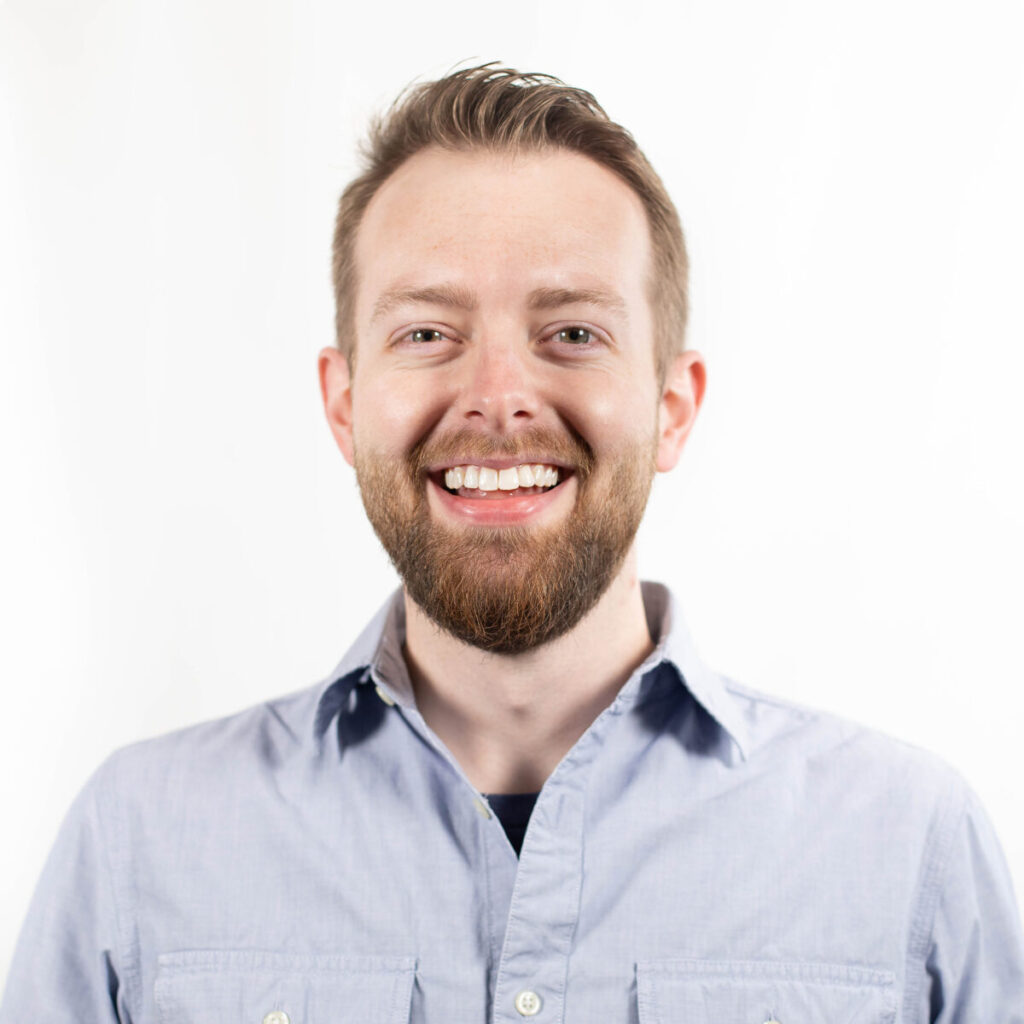
He then expanded on the stereotypes of creativity and how “It’s easy to assume that the teams with more visual output are the creative ones, but really all the people that work here are creative in their own ways — whether that’s figuring out the most efficient way to write a computer program or how we can solve the problem the best for the client, all the way down to figuring out how to schedule and organize a team of people working on something is a creative solution in itself.”
Collaborating With Others
Pixar President, Ed Catmull, said it best, “Creativity is not a solo act.” It takes a community to foster creativity, especially on big scale projects like a Pixar film. The way that Pixar fosters creativity is not by prioritizing innovative ideas, but by prioritizing good people.
For example, Toy Story 2 was a defining moment for Pixar when it became a critical and commercial success. The initial team on it wasn’t pulling through and the story wasn’t solid enough before animations were due, but when creative leadership was given back to the people who made the original Toy Story, it started to fall into place again.
Catmull went on to say that Toy Story 2 and how it came together taught them an important lesson “about the primacy of people over ideas.” He said, “If you give a good idea to a mediocre team, they will screw it up; If you give a mediocre idea to a great team, they will either fix it or throw it away and use it to come up with something that works.”
This lesson is extremely important because many people think they aren’t creative when they hit a roadblock or can’t come up with ideas on the fly. However, Catmull proves that creativity doesn’t start with ideas. It starts with people. It comes from consulting with others and collaboration, which is what the Corps is all about!
Projects at the Corps vary a lot in the sense of how many people are on them. Some projects have 15 people while others have seven or fewer. One of our biggest projects with the most people involved is The Loading Zone (TLZ). We use divergent thinking during our brainstorming sessions each semester. These brainstorming sessions are a great way for our team to come up with fresh ideas and even fresher scripts. Brainstorming for social media also takes a lot of people and time. Coming up with ideas all on your own is not as effective as throwing around ideas in a group.
To top that off, the reviews we send in for every caption, video, script, graphic, or animation we make are the definition of collaboration. Our projects would be nothing without our review chain going through so many people to perfect our projects. There’s a reason that not a single project at the Corps only has one team on it. The Loading Zone, for example, is not just a script. It’s an animated video that needs Design and Video Team members on it to create the show, just like Pixar.
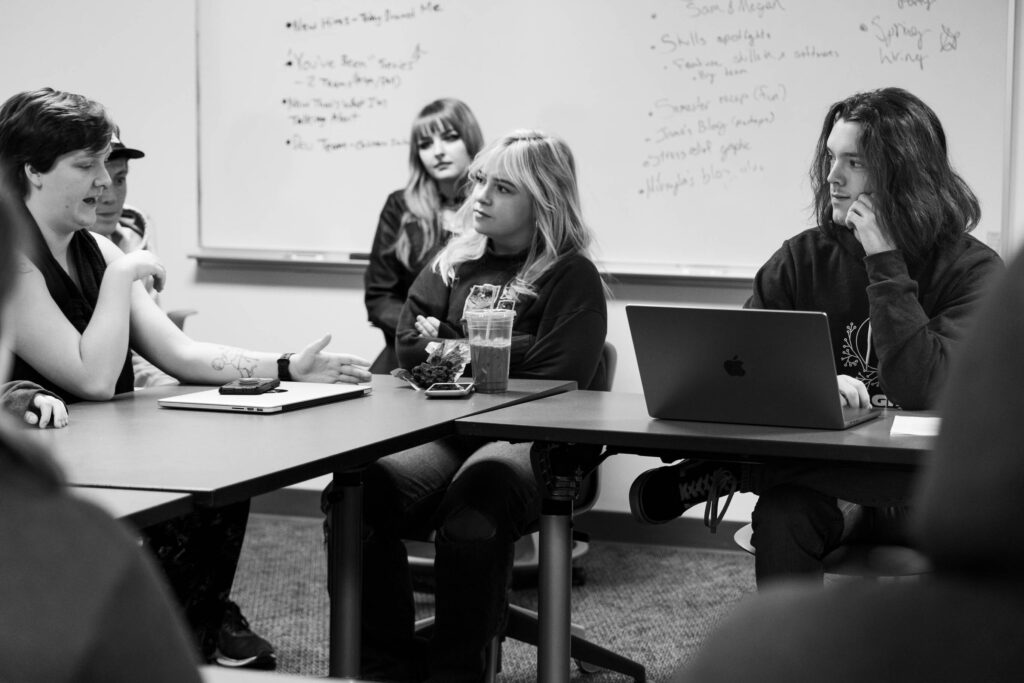
Digital Corps students from multiple teams, (from left) Sam K., Corey V., Desirée N., Jama T., and Peyton S., work together to brainstorm an idea for a project.
Sydney Chappell, a User Experience Apprentice at the Corps, says that she does feel more motivated when working with others because, “when there’s more people, you tend to have more ideas to bounce off of.” She also talked about how it’s motivating to see others do well and support them in their endeavors

Sydney has been dancing since she was a kid and now does hip-hop alongside her work at the Corps and school. When asked what inspires her, she said, “I feel like music inspires me a lot as a dancer, I hear music and see an image in my head. I [also] feel like just other pieces of art and designs [inspire me]. I see something, and I think ‘Oh that made me think of this, which makes me want to do this.’” As for people that inspire her, she said, “Sean Lew and Casey Rice…their musicality is so good, and they do hip-hop and contemporary [dancing].” Usually when she’s in a funk, she said “the people around me can see when I’m down and they know how to bring me back up. Or it helps to find time to be by myself and assess and fix things [on my own].”
Tips for Getting Inspiration
What inspires me when I’m in a creative rut is my emotions. When I’m sad or angry, I write poetry. When I’m happy, I’m more likely to watch a show or read a book. In work settings, it’s being around others! I feel most productive when I am around others who are working, even if it’s not on the exact same project.
GCFGlobal worded it perfectly: “You may think, ‘I don’t have time to sit down and create something every day.’ This is when it’s important to realize the difference between using creativity and creating something. In a lot of ways, creativity is all about how you see things.”
Creative thinking typically comes from sparks of inspiration and motivation. According to “HubSpot,” and fellow Corps students, there are many ways to get yourself up and going, although there is no set way to do this. Some tips they said included:
- 1. Drawing, painting, doodling (A Design Team go-to)
- 2. Morning freewriting (A Comm Team go-to)
- 3. Embrace your inner child
- 4. Brainstorm while doing physical activities
- 5. Collaborate! (Corps specialty)
- 6. Travel
- 7. Making/watching Tik Toks (I’ll expand on this in a bit)
- 8. Listen to funny/advice Podcasts
- 9. Take the time to discover new music, shows, and movies
- 10. Read up!
Corps students echoed these tips. In fact, listening to music as a means for gaining inspiration seems to be a common thread between Sydney Chappell and one of our Project Managers here at the Corps, Lauren Wineman.

Lauren Wineman makes content for TikTok in her free time. Lauren said, “I find so much joy in creating content and sharing things with people. I made little music videos with my friends when I was younger, so it’s fun to see little me pursuing what I still like to do. [Afterall], I went into social media marketing and everything.”
As for where she gets her inspiration from, she said, “I’ll find things [videos], hear a song or I’ll have something happen to me.” She gets inspired in a lot of different places but considers her own personal experiences and relatability to create most of her content.
Lauren also travels a lot. It’s something she loves and is also a good chunk of the content she creates. Lauren said that when she’s brainstorming for content ideas, she always uses convergent thinking to logically think about what content works on her platform and then uses divergent thinking to find a way to create that content, which works together to form a more lateral way of thinking.
The Bottom Line
There is no blueprint when it comes to creativity. Everyone is creative in their own ways and has different ways of finding inspiration, problem solving, creating, and staying motivated. No matter what your career field is or what type of thinker you feel you are, you can be creative every day. Whether you’re expressing that creativity through your hobbies or in your career, they will always meet at a crossroad.
If you take anything away from this blog, it’s that inspiration can come from something as small as reading an idea in a book to something as big as collaborating with multiple teams on a project. The Corps, and every career field, would be nowhere without creative thinking, collaboration, and inspiration. If you have ever thought that you are not creative or not as creative as others, I encourage you to take a step back and look at your day-to-day life. You just might surprise yourself!


